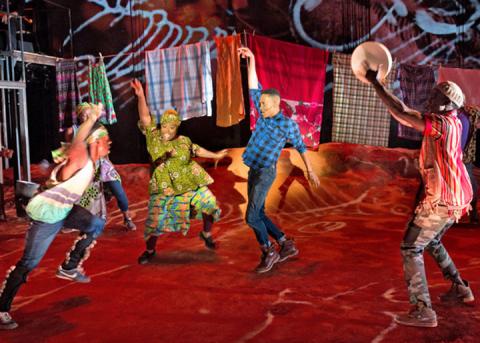
My Trip to Uganda with “Invisible Thread”
Self-employed
COPA Performing Arts Workgroup
This past fall I had the pleasure of working onsite with the incredible cast and creatives of ‘Invisible Thread the Musical.’ The musical is a true story of the creative team and lead actor's search for himself while creating a school for children in Uganda. The cast and crew were incredibly warm, talented and inclusive to all, which made my work more rewarding feeling that I was a part of something special.
As an athletic trainer on Broadway in the performing arts, the show had many imposing variables for which to overcome. First of all, we are usually only used for pre-show treatment after the show begins actual performances and begins to generate revenue. I was fortunate to be called in during pre-production and tech, which are what we call “10 out of 12ves”. During this time the director and choreographer can work the performers 10 hours in a 12 hour day! This can also be done during previews and include performances after rehearsal. Since the vast majority of performing arts injuries are over use, it was great that I was brought in so early in the run. This was a great use of risk mitigation and kept many injuries from becoming worse and causing a cast member to sit out.
With Broadway, since you may or may not know anyone in the cast, it always seems like the first day of school and you need to make introductions and develop trust rather quickly. The fact that this was a great group made that very easy.
The stage itself was the most challenging that I have ever worked with. In addition to being raked (a stage that is set on an angle), it was covered in dirt (yes, real dirt) over concrete with an undulating surface of potholes throughout simulating the terrain of Uganda. Cast members performing never knew where their foot would land or if they would hit the same spot in each performance, which makes it challenging to dance and perform full out each time. I was tasked with giving a lecture about the hazards of the stage as mandated by Equity, the actors union. Although the cast was more concerned with the rake of the stage, I was more concerned about the dirt and potholes. This was most important since we had actors jumping off ladders and catwalks onto the stage during performance. We had a myriad of low back and lumbopelvic dysfunction due to the rake of the stage and I spent a good amount of time using muscle energy techniques to realign the performers. We had two performers who developed injuries that may have turned into stress fractures but we caught them early enough and provided taping to offload the area so this did not occur. I also had a concussed stage manager who ran into a light and was told by a primary care physician to “go back to work, you are in tech!” She and I had a discussion about the danger in that and she was sent home and monitored. I am glad to report that we only sustained one major injury on the next to the last day, which was a mallet finger from a lift in the second act.
The producers thought that they had a show that could move to Broadway, but although the audiences loved the production the critics did not. We closed December 27th. Welcome to New York Theater. I still think and hope this show has a life after this run and feel fortunate to have been a part of something special and for the friends that I have made along the way. It is what being an athletic trainer in the performing arts is all about; touching people's lives and being challenged and moved by what you are a part of. I wouldn't have it any other way.





